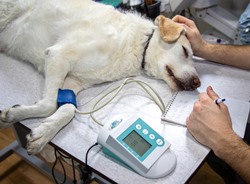Vet Technician School
How to Choose the Best One Near Stanford California
 Fulfilling your lifelong aspiration of working with and caring for pets by enrolling in a veterinary technician school near Stanford CA could initially feel like a challenging task. But in order to succeed as a working veterinary technician, you must first locate and ultimately enroll in a school that will provide the necessary education and training. But just how do you go about assessing and contrasting schools so that you can make the right choice? Many aspiring students launch their due diligence process by searching for colleges that are near their homes. Once they have located some area schools, they ascertain which ones have the cheapest tuition and focus on those. Although cost and location are significant factors when assessing vet tech schools, they are not the only important ones when making your assessments. Qualifications such as internship programs and accreditation need to be evaluated also. The point is that there are questions you should be asking the vet technician programs you are considering before you make a final decision. We have provided several in this article to help get you started, but before we review them we'll go over the various duties of vet techs and the training alternatives available.
Fulfilling your lifelong aspiration of working with and caring for pets by enrolling in a veterinary technician school near Stanford CA could initially feel like a challenging task. But in order to succeed as a working veterinary technician, you must first locate and ultimately enroll in a school that will provide the necessary education and training. But just how do you go about assessing and contrasting schools so that you can make the right choice? Many aspiring students launch their due diligence process by searching for colleges that are near their homes. Once they have located some area schools, they ascertain which ones have the cheapest tuition and focus on those. Although cost and location are significant factors when assessing vet tech schools, they are not the only important ones when making your assessments. Qualifications such as internship programs and accreditation need to be evaluated also. The point is that there are questions you should be asking the vet technician programs you are considering before you make a final decision. We have provided several in this article to help get you started, but before we review them we'll go over the various duties of vet techs and the training alternatives available.
IT TAKES JUST A FEW MINUTES TO START YOUR VET TECH CAREER BELOW
Vet Tech Training Options

Among the first decisions that you will need to make is if you want to train as a vet assistant, technician or technologist. Part of your decision may be dependent on the amount of time and money that you have to devote to your education, but the principal determiner will most likely be which specialty interests you the most. What technicians and assistants share in common is that they both work under the immediate direction of a licensed and practicing veterinarian. And while there are many functions that they can perform within the Stanford CA veterinary clinic or hospital, they can't prescribe medications, diagnose health issues, or perform surgeries. In those areas they may only provide assistance to a licensed veterinarian. There are technicians and technologists that work outside of the conventional vet practice, such as for animal shelters, zoos or police departments. Let's take a look at the responsibilities and training requirements for each specialization.
- Vet Assistants in almost all instances will have completed a structured training program, either as an apprentice or intern in a practice, or by completing a certificate program at a trade school or community college. As the name implies, their job function is to assist the veterinarians and vet technicians in the performance of their duties. Normally they are not involved with more complicated undertakings, for instance assisting with surgeries. Some of their typical functions may include working at the front desk, preparing and cleaning exam rooms and equipment, or handling animals during exams.
- Vet Technicians undergo more advanced training compared with assistants and generally acquire a two year Associate Degree, ideally from an American Veterinary Medical Association (AVMA) accredited program. They are in a sense the vet equivalent of medical nurses, since their basic job function is to assist vets with diagnosing and treating animal patients. Where they stand apart from veterinary assistants is that they are included in more involved activities, for example assisting with surgical procedures or providing medicine. All states currently require vet technicians pass a credentialing exam for either registration, certification or licensing.
- Vet Technologists are comparable to veterinary techs and essentially perform the same work functions. They are required to attain a Bachelor's Degree in veterinary technology, which usually requires four years to complete. Therefore the only real difference between a vet technician and a technologist is the technologist's more advanced level of education. But with an advanced degree comes more job opportunities, higher salaries and possible management positions. They are additionally required to pass a credentialing examination for either certification, registration or licensing.
Vet technicians and technologists can specialize in areas such as anesthesia, internal medicine or emergency care. A number may receive certification from the American Association for Laboratory Animal Science (AALAS) to work in Stanford CA labs or research facilities as well.
Veterinary Technician Online Programs Offered
 An approach that may make sense for those with a busy lifestyle or who are working full-time while going to veterinary school is to enroll in an online program. Because the classes are made available through the internet, students can study on their own timetable wherever a computer is available. The syllabus is taught using several methods, including slide shows, videos and live streaming webinars. And since most vet tech and technologist degrees require practical training, that part can typically be carried out as an internship or work study program at a local Stanford CA veterinarian practice or hospital. Distance learning, as it is also called, can in some instances decrease the cost of your education. Tuition and ancillary costs, such as for travel and study materials, may be lower compared to more traditional classroom courses. Just make certain that the program that you choose is accredited, either by the AVMA or another nationally recognized accrediting organization. With the online courses and the practical training, everything is included for a comprehensive education. So if you are disciplined enough to learn in this more self-reliant mode, an online vet tech school may be the perfect choice for you.
An approach that may make sense for those with a busy lifestyle or who are working full-time while going to veterinary school is to enroll in an online program. Because the classes are made available through the internet, students can study on their own timetable wherever a computer is available. The syllabus is taught using several methods, including slide shows, videos and live streaming webinars. And since most vet tech and technologist degrees require practical training, that part can typically be carried out as an internship or work study program at a local Stanford CA veterinarian practice or hospital. Distance learning, as it is also called, can in some instances decrease the cost of your education. Tuition and ancillary costs, such as for travel and study materials, may be lower compared to more traditional classroom courses. Just make certain that the program that you choose is accredited, either by the AVMA or another nationally recognized accrediting organization. With the online courses and the practical training, everything is included for a comprehensive education. So if you are disciplined enough to learn in this more self-reliant mode, an online vet tech school may be the perfect choice for you.
What to Ask Vet Tech Schools
 At this point you probably have decided on which veterinarian credential that you wish to attain, and if you prefer to study online or attend a college on campus. Since there are a large number of veterinarian community colleges, vocational and trade schools in the Stanford CA area and across the United States, you must ask some qualifying questions in order to fine tune your list of alternatives. As we discussed in our introduction, many future students start by focusing on location and the cost of tuition. But we have already pointed out other significant qualifiers, such as internship programs and accreditation. And naturally you want to select a college that offers the specialty and degree that you would like to earn. These and other qualifications are addressed in the list of questions that you need to ask the vet tech schools that you are considering.
At this point you probably have decided on which veterinarian credential that you wish to attain, and if you prefer to study online or attend a college on campus. Since there are a large number of veterinarian community colleges, vocational and trade schools in the Stanford CA area and across the United States, you must ask some qualifying questions in order to fine tune your list of alternatives. As we discussed in our introduction, many future students start by focusing on location and the cost of tuition. But we have already pointed out other significant qualifiers, such as internship programs and accreditation. And naturally you want to select a college that offers the specialty and degree that you would like to earn. These and other qualifications are addressed in the list of questions that you need to ask the vet tech schools that you are considering.
Is the Vet College Accredited? It's imperative that you make sure that the veterinary technician school you enroll in is accredited by a regional or national accrediting agency. As earlier mentioned, one of the most highly regarded is the American Veterinary Medical Association (AVMA). Trade schools and colleges that are accredited by the AVMA have gone through a thorough screening process that ensures you will receive a quality education. Also, accreditation is important if you are applying for a student loan or financial assistance, since a large number of programs are not offered for non-accredited colleges. And finally, having a certificate or degree from an accredited program is in many cases a precondition for employment for many Stanford CA area vet clinics and hospitals.
What is the Program's Reputation? The veterinary college or vocational school and program you choose should have an excellent reputation within the veterinary community. You can begin your due diligence by asking the schools you are looking at for references from the employers in their job placement network. Other tips include looking on online school ranking websites and checking with the school's accrediting organizations as well. You can ask the California school licensing authority if there have been any complaints or violations involving your targeted schools. As a final tip, call some Stanford CA veterinary clinics that you may want to work for after you get your training. Find out what they think of your school choices. They might even recommend one or more programs not on your list.
Are Internships Offered? The most effective means to obtain practical hands on training as a vet tech is to work in a medical environment. Find out if the programs you are reviewing have internship programs established with Stanford CA veterinarians, vet hospitals or clinics. The majority of veterinary medicine programs mandate clinical training and a large number provide it by way of internships. Not only will the experience be invaluable regarding the practical training, but an internship may also help develop connections in the local veterinary community and help in the search for a job after graduation.
Is there a Job Placement Program? Searching for a job after graduating from a vet tech college can be difficult without the assistance of a job placement program. To begin with, find out what the graduation rates are for the colleges you are evaluating. A lower rate could signify that the teachers were ineffective at teaching the course of study or that some students were disappointed with the program and quit. Next, check that the colleges have a job placement program and find out what their placement rates are. A high placement rate may signify that the program has an outstanding reputation within the Stanford CA vet community and has a significant network of contacts for student placements. A lower rate may indicate that the training is not well regarded by employers or that the job assistance program is ineffective at placing students.
How Big are the Classes? If the classes are larger, you most likely will receive little or no one-on-one instruction from the teachers. Find out from the Stanford CA schools you are considering what their class student to teacher ratios are. You may also want to attend a couple of classes (if practical) to monitor the interaction between students and instructors. Ask for evaluations from students concerning the quality of instruction. Also, talk with the teachers and find out what their backgrounds are as well as their approaches to teaching.
Where is the School Located? Okay, we already covered location, but there are several more points to make on the topic. If you are going to commute to your vet tech classes from your Stanford CA home, you must make certain that the driving time fits into your schedule. For example, driving during the weekend to investigate the route won't be the same as the drive during rush hour traffic, especially if the campus is located near or in a large city. Also, if you do opt to enroll in a college in another state or even outside of your County of residence, there may be higher tuition fees especially for state and community colleges. Of course taking online classes may be an alternative that will give you more flexibility and minimize the need for travel.
Is the Class Schedule Flexible? And finally, it's imperative that you ascertain if the vet schools you are exploring offer class times flexible enough to fit your schedule. For example, many students continue working full time and can only attend classes on the weekends or in the evenings near Stanford CA. Some might only be able to attend class in the morning or in the afternoon. Make sure that the class times you require are offered prior to enrolling. In addition, find out if you can make up classes that you may miss because of illness, work or family responsibilities. You might find that an online college is the ideal way to fit your vet training into your busy life.
Learn More About Becoming a Veterinary Tech in Stanford
Enroll in the Best Stanford Veterinary Technologist Program
Selecting the appropriate veterinary technician school is a critical first step to starting a rewarding career providing care and treatment for pets and livestock. Future students thinking about veterinary technician colleges must make their selection based on a number of key issues. Veterinary technicians and technologists work in veterinary clinics and hospitals and animal shelters. They usually handle administrative tasks and assist the veterinarian with the animals when needed. As we have discussed, it's very important that you choose a veterinary medicine program that is both accredited and has an outstanding reputation within the field. This applies to online vet tech schools as well. By asking the questions included in our checklist for assessing schools, you will be able to reduce your options so that you can make your final choice. And by picking the ideal program, you can achieve your goal of becoming a veterinary technician in Stanford California.
Stanford Veterinary Technician Schools | Stanford Online Vet Tech Programs
